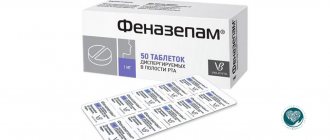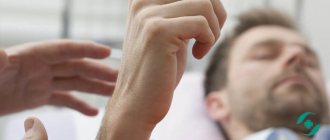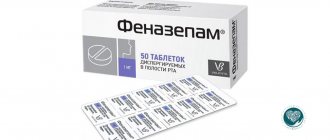Phenazem, a medicine first synthesized in the Soviet Union in 1975, was created to treat various neurological and psychological disorders. This benzodiazepine, similar to Valium, has a sedative effect on the patient.
As a central nervous system depressant with sedative properties, this drug is suitable for the treatment of anxiety and panic disorders, as well as epilepsy, insomnia, neuroses and alcohol withdrawal syndrome. The drug is available in powder form, in tablet form or in the form of a liquid solution. Nowadays it is increasingly used for recreational purposes. Indications for use
In the CIS, Phenazepam is used to treat the following symptoms:
• anxiety • insomnia • neurosis • increased irritability • brief psychosis • alcohol withdrawal syndrome • temporal lobe epilepsy • panic disorder
Phenazepam dosage
• In Russia, phenazepam tablets are usually given 2-3 times a day. Each dose ranges from 0.25 to 0.5 mg, depending on the patient's needs. In clinical settings, the dose may be increased to 3-5 mg per day.
Phenazepam overdose
An overdose of benzodiazepines can be extremely dangerous and fatal. The maximum safe dosage of the drug is 10 mg for one day.
Possible symptoms of phenazepam overdose: • loss of consciousness • depressed breathing • delirium • slurred speech • inability to stand or move • unresponsiveness
Content:
- Causes of dependence on phenazepam
- Why does psychological addiction occur?
- Causes of physical addiction
- Withdrawal syndrome from phenazepam
- Signs of withdrawal
- How long does it take for withdrawal to go away?
- How to wean yourself off phenazepam
Phenazepam is a tranquilizer drug. Prescribed for serious neurological and mental diseases. May cause dependence if used for a long time. Withdrawal from phenazepam is no easier than when getting rid of heroin, cocaine and other addictions. What are its symptoms, how long does it last and how to survive it? Let's look at it in more detail next.
Analogues and their dangers
Bromodihydrochlorophenylbenzodiazepine is included in a large number of drugs that are analogues of Phenazepam. In some, the concentration of the active substance does not exceed the recommended daily dose, so they are not considered a pharmaceutical drug. The most dangerous analogue is Fenzitate. It has a composition similar to Phenazepam. Long-term use causes severe liver and kidney damage and drug addiction.
Alprazolam is also a tranquilizer, a benzodiazepine derivative. As in the case of an overdose of Phenazepam, taking large doses of this drug causes suicidal thoughts, outbursts of aggression, confusion, and increased excitability.
Bromazepam, taken in small doses, has an anxiolytic effect on the body. And if the recommended volume is exceeded, it is sedative and muscle relaxant. High risk of developing addiction.
Gidazepam differs from other tranquilizers in the family by the absence of a hypnotic effect. The danger of the drug appears when combined with ethanol and antipsychotic drugs, as it leads to increased effects on the central nervous system.
Causes of dependence on phenazepam
By law, it is available with a doctor's prescription. Unfortunately, not all pharmacy workers are conscientious and can sell the drug without a prescription. Phenazepam is sometimes prescribed for withdrawal symptoms from other drugs. Despite this, it itself can become highly addictive.
Moreover, you don’t have to be a drug addict who has decided to replace one addiction with another. For example, a person with neurosis did not like the sedative that was prescribed to him. He decided to find something more effective and purchased this product. Addiction to this pharmaceutical drug occurs both at the psychological and physiological levels. Let's take a closer look.
Danger of consumption methods
Phenazepam is presented on the pharmaceutical market in two forms - tablets and solution for injection. If you strictly follow the instructions and medical recommendations, these methods of use do not pose any danger.
When administered orally in large doses of Phenozepam, it accumulates in the liver and bloodstream. Because of this, damage to the gastrointestinal tract occurs. The course of chronic pathologies may be aggravated.
The most popular and frequently used method of administering the drug among drug addicts is injection. Due to chronic use, peripheral veins become sclerotic. Not only pharmaceutical solutions can be used for injections. Sometimes they are prepared independently by dissolving the tablets in saline solution. The danger is that additional ingredients often block the pulmonary capillaries, which causes chronic inflammation and granulomatosis.
Causes of physical addiction
Physical dependence on phenazepam is due to the fact that this medication has psychoactive properties.
The drug affects biochemical processes in the brain, stimulating the production of dopamine, a hormone that causes a feeling of euphoria and joy. Tolerance to the drug increases, and the addict requires more and more doses. If he does not receive enough of it, withdrawal syndrome develops. The person cannot stop and uses more and more of the drug. This is how a vicious circle is formed. Dependence on many other drugs also develops. And the longer drug use lasts, the more difficult it is to stop using them later.
Drug overdose
The average daily dosage of Phenazepam is 5 mg. Addicted people consume several times more in the same period of time to achieve the desired effect. This leads to severe intoxication, which manifests itself in deep disorientation in space, accompanied by delusions and hallucinations. Psychosis often develops. The most dangerous signs are slowing of external respiration, dysfunction of the heart and kidneys.
If, in case of a severe overdose, medical assistance is not provided in a timely manner, deep depression of consciousness develops, but with preservation of reflexes. The person then falls into a coma.
Main reasons
A number of factors contribute to the development of intoxication. For example, a patient independently taking a dosage that exceeds that prescribed by a doctor. More often this happens due to the ineffectiveness of the therapeutic course. But the excess must be systematic.
The desire to commit suicide leads to an overdose. It is known that Phenazepam often causes suicidal thoughts and depression, and therefore is not prescribed to patients with severe forms of mental disorders.
Another reason is the simultaneous use of Phenazepam and alcohol, antidepressants, analgesics, and sedatives. They enhance the developing effect of euphoria, forcing you to take increasingly larger doses.
First aid
When the first signs of an overdose appear, it is important to call an ambulance. If the person is conscious, they induce vomiting. To do this, you can give a weak solution of potassium permanganate to drink. Then they give a sorbent - Activated carbon, Enterosgel, Smecta, Polysorb. Drugs of this type collect the remnants of Phenazepam metabolites and remove them naturally. If vomiting cannot be induced, take a laxative or give a cleansing enema.
If the victim loses consciousness from time to time, he is allowed to sniff cotton wool soaked in ammonia. Patting the cheeks and also rubbing the ears are effective. You can also try having a distracting conversation.
Health care
In the event that it was not possible to cleanse the intestines at home, this procedure is carried out by employees of a specialized team, introducing water through a tube. To clean the circulatory system, saline and glucose are administered.
After stabilization of the patient's condition, he is sent to the hospital. Here they continue to cleanse the body with NaCl and glucose. Be sure to add Anexat or any other drug containing flumazenil to the solution.
Consequences of lack of help
Drug intoxication threatens the development of dangerous complications. The use of Phenazepam in large doses affects the respiratory system. More often this manifests itself in secondary pneumonia.
Failure to provide assistance causes cerebellar ataxia, which manifests itself in impaired coordination of movements. Another consequence is inflammatory damage to the kidneys, since Phenazepam is excreted by the kidneys.
Other consequences include:
- depression, anxiety;
- functional liver damage.
Other phenomena may be observed. It all depends on how long ago the addiction was formed and what doses were administered. The presence of chronic pathologies is also important.
Lethal dose
Phenazepam is taken regardless of food intake in dosages selected by the doctor taking into account the severity of the condition. Volumes of the drug for various disorders according to the manufacturer’s recommendations:
- anxiety attacks - up to 2 mg per day;
- neurotic disorders - from 0.5 to 1 mg two or three times a day;
- sleep disorders - 0.25-0.5 mg half an hour before bedtime;
- epilepsy - 2–10 mg per day;
- muscle tone, central nervous system damage - 2-3 mg twice a day;
- abstinence – 2–5 mg per day.
Exceeding the maximum daily dosage of 10 mg can lead to coma - superficial and deep. Further increase in volume leads to death.
How to terminate
Even after carrying out the necessary medical protocols for intoxication with Phenazepam, some of the metabolites remain in the body. To completely stop their negative effects on the body, an antidote, flumazenil, is administered.
This drug has a blocking effect on receptors that are affected by drugs of the benzodiazepine group. Initially, 200–300 mcg is administered. You can give no more than 2 mg again. Limitation: individual intolerance.
The antidote is administered exclusively in a hospital setting. If the victim has epilepsy, taking Phenazepam reduces the body's convulsive readiness. A developed seizure can develop into status epilepticus.
Withdrawal
In medicine, this condition is called withdrawal syndrome. It develops after the previous dose wears off or the addict begins treatment. The risk of development is higher, the larger the volume taken and the period of use.
In the structure of the syndrome, two groups of disorders are distinguished:
1. Mental:
- irritability;
- tension;
- depressed mood;
- anxiety;
- agitation or lethargy;
- increased fatigue;
- depersonalization;
- decreased quality of sleep, nightmares.
2. Somatoneurological:
- increased sweating;
- tachycardia;
- decreased blood pressure;
- dizziness;
- headache;
- paresthesia, hyperesthesia;
- hot flashes of chills.
Often, drug addicts develop small-scale tremor of the fingers when they stretch their arms. Coordination of movements is impaired, speech is difficult. On days 2–3, fibrillary twitching of the muscles of the face, upper and lower extremities begins. Convulsive seizures and psychosis may appear.
The duration of withdrawal symptoms when stopping Phenazepam is about 30 days. Upon completion, physical and psychological exhaustion, lethargy, and weakness are clearly expressed.
How to ease withdrawal symptoms
During withdrawal symptoms, the drug addict should be placed in an inpatient unit at a specialized clinic. Under constant medical supervision, the concentration of Phenazepam is gradually reduced, since sudden withdrawal will lead to the collapse of internal organs. In parallel with this, the person attends psychological trainings, where he learns to deal with anxiety, depression and suicidal thoughts.
To relieve the clinical picture, a course of flumazenil or other drugs based on this substance is carried out. They eliminate the inhibitory effect on the central nervous system, especially drowsiness. If decreased diuresis is observed, it is increased with diuretics (for example, Novurit).
In case of severe poisoning with Phenazepam, hemodialysis is indicated.
Signs of withdrawal
The patient's condition is partly similar to influenza or ARVI. Symptoms of withdrawal after phenazepam are as follows:
- anxiety;
- irritability;
- sleep problems (insomnia, nightmares, frequent awakenings at night);
- heightened hearing;
- pain in muscles, head and throat;
- lack of appetite, nausea, vomiting;
- itching of the skin;
- chills;
- general feeling of weakness;
- aggressiveness;
- dysphoria;
- temporal and spatial disorientation;
- hypotension;
- excessive sweating;
- dizziness;
- tremor;
- increased sensitivity to light and sounds;
- depersonalization;
- anxiety-depressive syndrome;
- dizziness;
- speech problems;
- blurred vision.
Consequences of long-term use
If Phenazepam is taken for a long period of time in dosages exceeding therapeutic ones, the side effects intensify. For example, the manifestations of allergies become more pronounced. Quincke's edema is often associated with itching and peeling of the skin.
Angioedema is dangerous due to respiratory arrest and, as a result, death. While taking a tranquilizer, the risk increases.
Phenazepam worsens the quantitative and qualitative characteristics of blood. After cancellation they are restored. But the long stay of bromodihydrochlorophenylbenzodiazepine in the body makes this impossible. Therefore, drug addicts often get sick, their blood clotting is impaired.
Addicts suffer from severe headaches and find it difficult to retain even small amounts of information in their memory. Over time, independent movement becomes problematic due to developing problems with orientation. Muscle pain increases. Unpleasant sensations that cannot be relieved force you to take a new dose.
Phenazepam, taken in large dosages and for a long time, causes disorders of the cardiovascular system - surges in blood pressure, tachycardia.
How to wean yourself off phenazepam
People who care about a drug addict are interested in how to stop and how to survive addiction. The treatment process takes place in three stages.
The first stage is detoxification. The patient is given intravenous drips based on drugs that facilitate the withdrawal process.
Important! The gradual elimination of the drug from the body and the remaining stages of treatment should be carried out in a drug treatment clinic under the guidance of doctors.
The hospital environment facilitates the use of the latest treatment methods. The detoxification program can be carried out not only through IVs, but also through the use of hardware methods, and in special cases, intensive therapy measures.
The second stage is rehabilitation. It concerns both drug treatment and work with the patient’s habit. For each patient, individual methods of working with a psychotherapist, one-on-one or group therapy, are selected. For example, there are the following methods:
- art therapy is “therapy with art”, mainly drawing;
- Gestalt therapy, which focuses on the characteristics of the patient necessary to meet his own needs and the needs of people around him;
- kinesiotherapy - treatment through physical activity;
- transactional analysis, which deals with ego states (“parent”, “child”, “adult”).
Some facilities offer meditation and yoga classes.
Skills that patients gain during the rehabilitation process:
- control over one’s own desires, incl. over repeated cravings for phenazepam;
- the ability to solve problems independently, without stimulants in the form of psychoactive substances.
And finally, the third stage is resocialization. It, like the two previous stages, should in no case be neglected. Since a person is a biosocial personality, he cannot live fully without communication. If you do not engage in resocialization, remission will not occur. Therefore, a person needs to return to society.
When a person is addicted to drugs, many people turn away from him. To once again become a full-fledged member of society, it is worth going through two stages of socialization.
First, group work is carried out with other patients. When physical and mental dependence on phenazepam has been eliminated, former drug addicts are placed in institutions outside the rehabilitation center. There, participants in the resocialization program are in small groups. Thanks to this, they learn to interact with each other and perform certain duties. Sometimes they even take retraining courses.
The next stage is working at the patient’s home. Relatives should support him not only during clinical treatment. In addition to full communication, it is necessary to ensure that he does not return to his previous environment. Otherwise, addiction may arise again, this happens in 99.99% of cases of returning to former drug-addicted friends.
Often the help of psychotherapists is needed, who work not only with the patient, but also with his environment. It happens that a person becomes a drug addict due to a negative atmosphere in the family. If it remains the same, after treatment he will break down and start taking phenazepam again without a doctor’s prescription.
Please note that achieving positive results requires a comprehensive approach. Thanks to the coordinated work of specialists of different profiles, a person gradually regains the ability to independently build his life. Over time, he can achieve success in his career, start a family, discover new horizons for himself - experience what was previously inaccessible due to drug addiction.
Test for Phenazepam
Determination of phenazepam in biological fluids is necessary primarily in cases of severe poisoning.
Symptoms of overdose are non-specific, so tests are immediately carried out for other psychoactive substances with a similar effect. In the acute phase, blood is examined, but urine is considered a more convenient material. In forensic practice, the result must be confirmed using several methods. The most effective are the following:
- GC-MS - gas chromatographic analysis with mass spectrometry.
- HPLC-MS/MS is high-performance liquid chromatography with tandem mass spectrometric detection.
Rapid tests work on the principle of the immunochromatographic method. The strip is used immediately before the test strictly according to the instructions. There are many manufacturers of quick tests (“Narcoscreen”, “CreativeMP”, “Narcochek”), so differences are possible.
The rate of metabolism of psychoactive substances is influenced by individual characteristics, excess weight, the size of the dose taken, as well as the length of abuse.
Blood is suitable for analysis for only 12-18 (24) hours. Phenazepam remains in the urine for up to 4 days.
Indications for use
When taking this substance, the following effects develop:
- anti-anxiety;
- anticonvulsant (anticonvulsant);
- hypnotic;
- sedative (calming);
- muscle relaxant (this means muscle relaxation).
Phenazepam is prescribed to patients with diseases that cause:
- anxiety;
- panic attacks;
- fears;
- irritability;
- psycho-emotional instability;
- epileptic seizures;
- insomnia.









